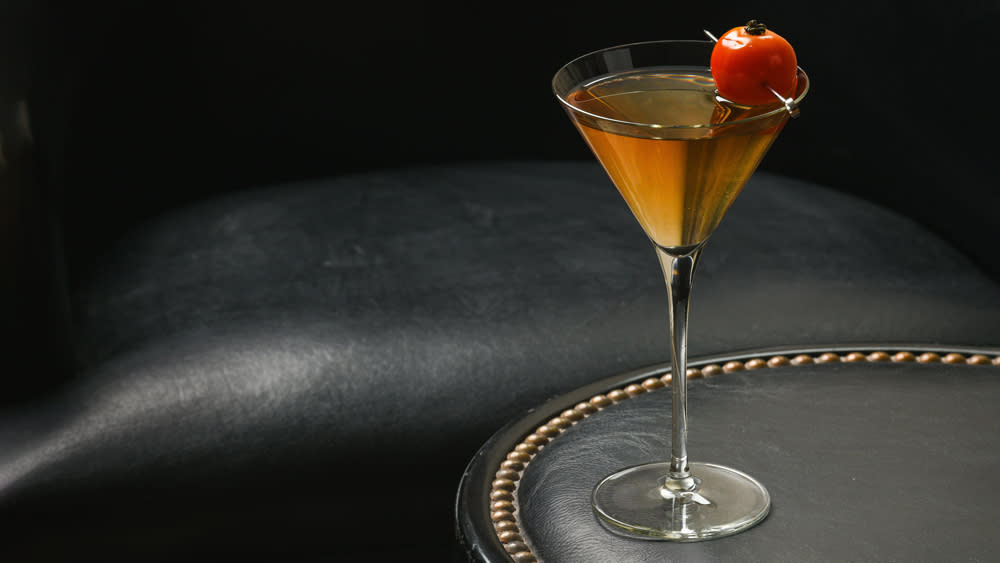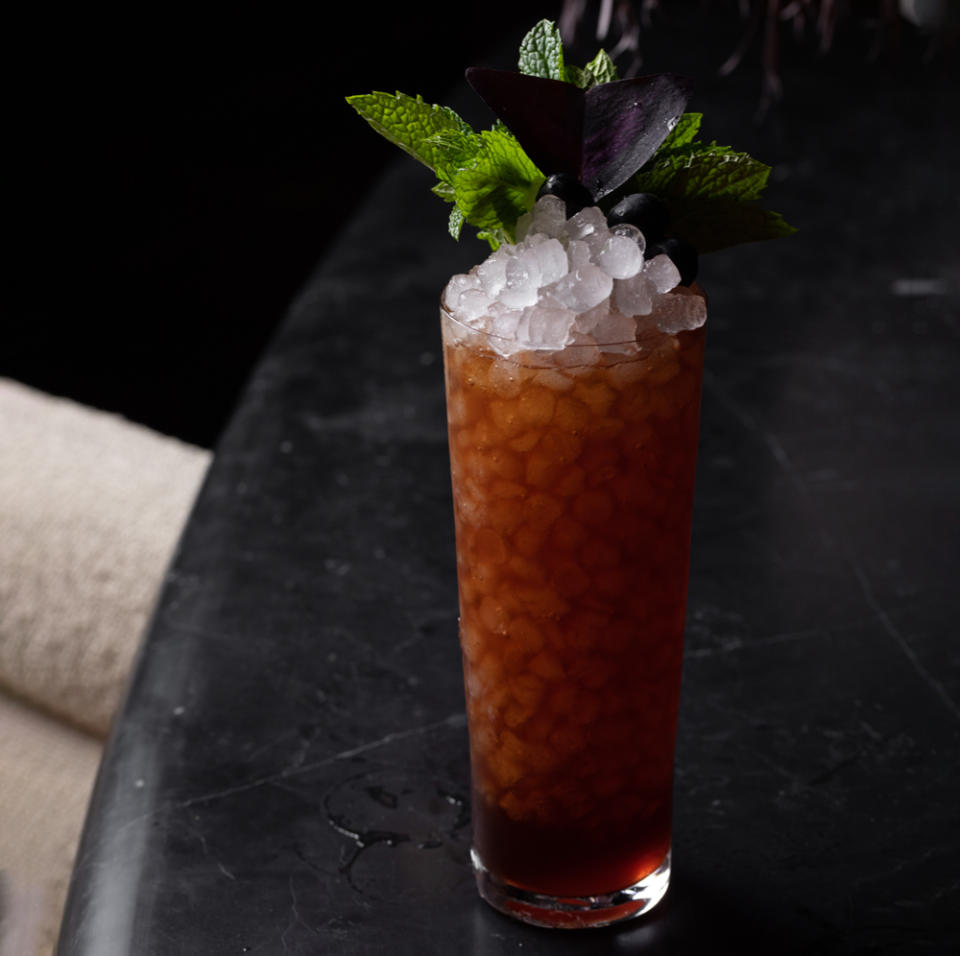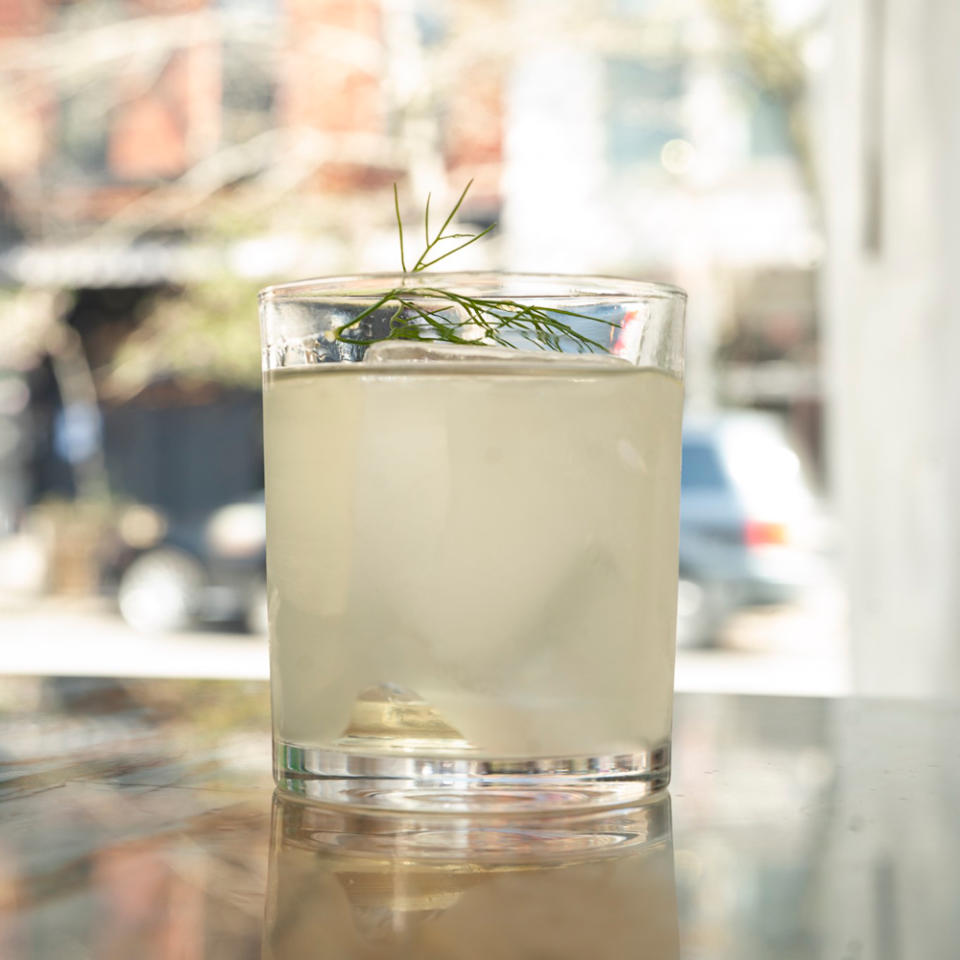Why New York Bartenders Are Suddenly Adding Oil and Vinegar to Your Cocktail

To create his twist on the sherry cobbler, bartender Matt Reyson didn’t go digging around his well to find the key ingredient. Instead, the bar director at New York City’s Al Coro raided the Italian restaurant’s Michelin-two star kitchen to swipe a bottle of 12-year-old of aceto balsamico di Modena I.G.P. He proceeded to combine that vinegar with gin, sherry, aperitivo, concord grape, and lemon to create the delightful cocktail he calls Kind of Blue. He’s played around with the ingredient in his recipes before. At Reyson’s previous posts—including acclaimed cocktail bars Dante and Dead Rabbit—a good balsamic had become his workhorse, with its deep flavor faring well in nonalcoholic and boozy drinks alike. He’s not alone.
Between the balsamic vinegar in Al Coro’s Kind of Blue; the Champagne vinegar in Little Rascal’s Strict Tempo; the Clementine Shrub Vinegar in Apotheke NoMad’s Among the Sunbathers; the extra virgin olive oil and balsamic vinegar in Jac’s on Bond’s Caprese Martini, and the Sicilian olive oil in Principe’s Negroni Verde—to name just a few—oil and vinegar aren’t just for salad dressings anymore. The ingredients are finding their way into some of New York City’s best cocktail programs as bartenders take a culinary turn.
More from Robb Report
How to Make a Pink Lady, a Springtime Gin Cocktail That's Tart and Frothy
This Chicago Bar Is Serving an $800 Mai Tai Made With the Original Ingredients From the 1940s
We Blind Taste Tested Top-Shelf Vodkas. Here Are the Results.
Trevor Easton Langer, bartender at Jac’s on Bond, one of the hottest new bars in the city, created the Caprese Martini (olive oil, tomato and basil-infused Grey Goose Vodka, Lustau blanco, and balsamic vinegar) because of his love of the classic Italian tomato, mozzarella, and basil dish. “All the flavors in the drink harmonize so beautifully, the same way that they do when it’s plated as a salad,” says Easton Langer, who also wanted to mimic the dish by giving the drink a “velvety mouthfeel.” The balsamic serves to add acidity, of course, but it’s balanced by the silkiness of the oil—just like in the salad itself.

While Easton Langer sees the oil and vinegar cocktail additions as relatively new, at least in New York, he also believes it’s part of an ongoing effort to craft drinks similarly to how chefs create dishes. “We want to get to the point where people are respecting cocktails the same way that they are respecting food,” Easton Langer says.
Reyson’s cocktails seem drawn from similar aspirations. “Right now, we’re going through this kind of culinary existence where you’re seeing a lot of savory components in beverages.”
Reyson says culinary-influenced drink menus are already quite popular in the U.K., Mexico, and Singapore. People are reacting well and it’s a fuller drinking experience, he believes—one that’s not about “drinking to get drunk” but drinking with a focus on what’s really being tasted.
Alan Wither, Principe’s beverage manager, is taking the opportunity to flex his culinary school cred—and deep understanding of complementary flavor profiles—through a couple of the Soho restaurant’s cocktails. On the menu now there’s a Calabrian Chili Margarita, composed of tequila, Aperol, bell pepper, Calabrian chili, and lime; as well as the surprising Negroni Verde made from gin, Luxardo bitter bianco, Chartreuse, fennel (in the form of a fennel liqueur), and olive oil.
Wither describes the not-too-peppery olive oil from Sicily (also used on the restaurant’s Fior di latte), as having a “nice, buttery texture,” in a savory drink that still manages to be refreshing. A couple of drops is all it takes, says Wither, who added that the olive oil is “the last touch to open up the aromas [of the drink].”

When constructing his cocktails, Wither says his culinary background is “definitely a driver in most of my thought processes.” It comes into play with each new experiment and the Negroni Verde is no different. Like many of Wither’s drinks, the quirky Negroni iteration lends itself to a food pairing experience if that’s what you’re after, says Wither.
Because not everyone wants to drink wine with dinner; “there are other options,” Reyson points out, and Al Coro’s beverage menu is designed with this in mind. “I wanted to take familiar beverages and drinks that paired well with food and translate them into my own kind of nuanced beverage with the addition of highlighting Italian produce or flavors,” Reyson says.
This culinary approach creates a more dynamic and versatile cocktail menu. That’s why Reyson and other bartenders will keep raiding the kitchen for ingredients like oil and vinegar, so they can mix drinks that work on their own or as a pairing. It’s led them to rethink what goes into a cocktail, because as Reyson says about his philosophy at Al Coro, “It’s more about flavors and translating them into liquid.”
Best of Robb Report
Why a Heritage Turkey Is the Best Thanksgiving Bird—and How to Get One
The 10 Best Wines to Pair With Steak, From Cabernet to Malbec
Sign up for Robb Report's Newsletter. For the latest news, follow us on Facebook, Twitter, and Instagram.

